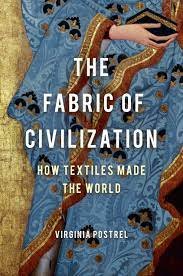Episode 62: Virginia Postrel
Tracing Textile History and Threads That Connect Cultures
Textiles have played a significant role in our history and culture, starting with the Stone Age and continuing to the present. As award-winning journalist Virginia Postrel tells us, thread and fabric played are catalysts in revolutionizing human labor and innovations that economic historians often overlook.
The Fabric Of Civilization is Virginia's book on textile history that stitches our aesthetics, history, and cultural identity. It focuses on textiles as among the oldest, most essential, and most pervasive of human inventions.
In this episode, Virginia reminds us that people around the world are all woven together through our shared experiences, from using a string to hunting food to making clothes with artistic patterns.
Episode Quotes:
What is the significance of a string to man during the Stone Age?
“Lots and lots of things become possible because of string. One of which, as you alluded to is you can take your stone, weapons or whatever, your stone knives, and you can attach them to a stick and make a spear or an arrow. Those sorts of things become possible. So it's a critical, very early technology.”
Why do scholars often overlook the contributions and importance of textile in human history?
“There was a paper published where people had identified Neanderthal strings that were 50,000 years old, really old strings. So it's very important technology, but string rots and stones don't so that people didn't really think about looking for string and or later on, 10,000 years, rather than 50, looking for textiles. Our minds are shaped by what is left and what is left is the hard stuff.”
How did spinning machines affect the economy of weavers in the late 18th century?
“Before the spinning machines, weavers had often been idle because they couldn't get enough thread to weave. Once the spinning machines came in, there was an expansion of demand for weavers and weavers made good money for the day. And it was what one historian calls a golden heyday for them, but that lasted about a generation.”
Why did the group of Luddites resist the use of power looms despite improving the productivity of weavers?
“They were not ideologues. They were not people who had some cultural distaste for technology or something like that. They were just guys who didn't want to lose their jobs, at a time when losing your job could mean starving. This is serious business. But they smashed looms and the government said you can't do that. Few people were executed, actually because of violent actions. A lot of people were deported to Australia. But the looms continued and we had this enormous expansion of productivity.”
On weaving as the birthplace of computing.
“Weaving is the original binary operation. Because you either are lifting a thread or you're not lifting. You're going over or under, you've got this one or zero intrinsic process. And so, people have been figuring out ways to record and remember those patterns for thousands and thousands of years. In the 19th century, Jacquard came up with a way of mechanizing or automating really some of the most complicated kinds of weaving, which had been done on what are cultural looms.”
How can traditional textile artisans around the world preserve their art?
“The thing that I think is important is that for these crafts to survive in ways that don't condemn people to eternal poverty is they have to be luxurious. They have to be things that are special.”
Time Code Guide:
00:02:19: The String Age
00:04:42: Archeologist’s work on prehistoric textile
00:08:15: The Development of Spinning Machine in the Industrial Revolution
00:10:47: The labor-intensive process of making thread for Viking sail
00:11:43: The Women-dominated Thread industry
00:14:49: Silk weaving before the Industrial Revolution that produced economic ecosystem
00:17:31: Industrial espionage in the Silk Weaving Technology
00:20:00: Resistance movements against production and technological advancement in textile
0:23:00: Metaphors of weaving in English language
00:25:18: Weaving as the original binary operation
00:28:27: Creating patterns through weaving
00:30:55: Mathematical concepts in weaving
00:33:54: The European Cloth Trade
00:36:58: Stinky fabric dyes from snail glands
00:42:09: Global production of indigo dye
00:44:14: Aesthetic expression in historic textiles
00:45:01: The human value of aesthetics
00:48:56: The art of expressing identity through clothing styles
00:52:57: Meanings of clothing styles evolve over time
Show Links:
Guest's Profile:
His Work:








